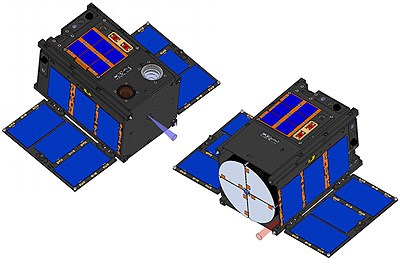Thank you very much for visiting Gunter's Space Page. I hope that this site is useful and informative for you.
If you appreciate the information provided on this site, please consider supporting my work by making a simple and secure donation via PayPal. Please help to run the website and keep everything free of charge. Thank you very much.
AeroCube 10A, 10B (JimSat, DougSat)

AeroCube 10B and 10A [Aerospace Corp.]
AeroCube 10 (AC10) are a pair of 1.5U Cubesats developed by the Aerospace Corporation of El Segundo to demonstrate several technologies.
The purpose of the mission is to demonstrate
- precision satellite-to-satellite pointing,
- deployment of atmospheric probes for in-situ measurement of air density,
- small-spacecraft proximity operations using propulsion from a steam thruster (no docking is planned), and
- solar cell performance degradation experiment that will correlate data from radiation sensors tuned to the energy levels suspected of causing damage to a drop in solar cell power output.
The AeroCube-10a spacecraft has two payloads. The first is a dispenser with a magazine of 29 identical atmospheric probes. Each probe weighs 16 grams and consist of three 98 mm diameter aluminum sheets at 90 degrees to each other, effectively forming a sphere. The intent is to be lightweight and have a constant cross section, independent of orientation to the velocity direction so that atmospheric drag can be measured in-situ. RF modeling predicts that the atmospheric probes will have a radar cross section equal to 1U CubeSats, which have been tracked on-orbit many times. The probes are dispensed individually upon command and it is predicted that each has a lifetime of 0.74 years when deployed from the highest altitude of 500 km. The second payload is an optical beacon. It is used to verify that the AeroCube-10a satellite is indeed pointing at the AeroCube-10b. It consists of a 4 W laser diode with a 1° full-width-half-max beam divergence.
The AeroCube-10b spacecraft replaces the payload volume area used for the dispenser on the 10a satellite with three different payloads. One is a steam propulsion unit identical to the one in AeroCubes-7b and 7c. It will dispense water vapor to create a 4 mN thrust to change the range between the two satellites. It holds up to 30 grams of water and can affect, best case a 10 meter per second delta velocity. Water is non-toxic and the pressure inside the steam propulsion unit is at atmospheric pressure, so it is not a pressure vessel. The other is an electron and proton spectrometer called the micro-Charged Particle Telescope (μCPT). It will measure radiation flux impinging on the satellite, in specific energy levels that are suspected to cause solar cell degradation. The third payload is a sensor that will confirm when the optical beacon is impinging on the satellite. It is a light sensor, tuned to the optical beacon and amplified because the intensity is predicted to be faint.
The satellites were deployed on 8 August 2019 from Cygnus CRS-11.
| Nation: | USA |
|---|---|
| Type / Application: | Technology |
| Operator: | Aerospace Corporation |
| Contractors: | Aerospace Corporation |
| Equipment: | |
| Configuration: | CubeSat (1.5U) |
| Propulsion: | |
| Power: | 2 deployable fixed solar arrays, batteries |
| Lifetime: | |
| Mass: | |
| Orbit: | 400 km × 400 km, 51.6° (typical) |
| Satellite | COSPAR | Date | LS | Launch Vehicle | Remarks | |
|---|---|---|---|---|---|---|
| AeroCube 10A (JimSat, AC 10-A) | 2019-022D | 17.04.2019 | WI LC-0A | Antares-230 | with Cygnus CRS-11, VCC A, B, C, Bird JPN, Bird LKA, Bird NPL, IOD-GEMS, SpooQy 1, Światowid, KrakSat, AeroCube 10B, SASSI2, Seeker, EntrySat, ThinSat 1A, ..., 1L | |
| AeroCube 10B (DougSat, AC 10-B) | 2019-022C | 17.04.2019 | WI LC-0A | Antares-230 | with Cygnus CRS-11, VCC A, B, C, Bird JPN, Bird LKA, Bird NPL, IOD-GEMS, SpooQy 1, Światowid, KrakSat, AeroCube 10A, SASSI2, Seeker, EntrySat, ThinSat 1A, ..., 1L |
References:
- AeroCube 1
- AeroCube 2
- AeroCube 3
- AeroCube 4A, 4B, 4C
- AeroCube 5A, 5B, 5C
- AeroCube 6A, 6B (CubeRAD A, B)
- AeroCube 7A, 7B, 7C (OCSD A, B, C)
- AeroCube 8A, 8B, 8C, 8D (IMPACT A, B, C, D)
- AeroCube 9 (LMPC)
- AeroCube 10A, 10B (JimSat, DougSat)
- AeroCube 11A, 11B (TOMSat EagleScout, TOMSat R3)
- AeroCube 12A, 12B
- AeroCube 14A, 14B (IMPACT 2A, 2B)
- AeroCube 15A, 15B (Rogue Alpha, Beta)
- AeroCube 16A, 16B
